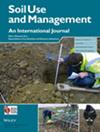Optimum planting density of Amorpha fruticosa promotes the recovery of understory vegetation and the arbuscular mycorrhizal fungal community in plantations in arid coal mining areas
IF 3.7
3区 农林科学
Q1 SOIL SCIENCE
引用次数: 0
Abstract
Establishment of plantations may be a useful means of vegetation reconstruction in coal mining areas, especially in fragile environments. However, the influence of shrub planting on the relationship between understory vegetation and soil microorganisms remains poorly understood. Here, we describe a field experiment in which the relationships between understory vegetation and soil microorganisms under different planting densities of最佳种植密度促进干旱采煤区人工林林下植被和树胶菌根真菌群落的恢复
在煤矿开采区,尤其是在环境脆弱的地区,建立植被可能是重建植被的有效手段。然而,灌木种植对林下植被和土壤微生物之间关系的影响仍然知之甚少。在这里,我们描述了一项野外实验,该实验研究了不同灌木种植密度下的林下植被与土壤微生物之间的关系。与自然恢复地区相比,灌木种植改变了群落,增加了林下植被和土壤微生物的生物量,尤其是丛枝菌根真菌(AMF)。种植密度也是影响林下植被和土壤 AMF 群落及生物量的关键因素。在引入灌木的中等密度下,林下植被和 AMF 群落的多样性最高,这被认为是 A. fruticosa 的最佳密度。此外,还研究了影响林下植被和 AMF 群落的主要土壤养分循环。引入灌木的最佳密度对于煤矿区植被的生态重建非常重要。在实验条件下,林下植被与土壤微生物,特别是与 AMF 之间也可能存在最佳关系。
本文章由计算机程序翻译,如有差异,请以英文原文为准。
求助全文
约1分钟内获得全文
求助全文
来源期刊

Soil Use and Management
农林科学-土壤科学
CiteScore
7.70
自引率
13.20%
发文量
78
审稿时长
3 months
期刊介绍:
Soil Use and Management publishes in soil science, earth and environmental science, agricultural science, and engineering fields. The submitted papers should consider the underlying mechanisms governing the natural and anthropogenic processes which affect soil systems, and should inform policy makers and/or practitioners on the sustainable use and management of soil resources. Interdisciplinary studies, e.g. linking soil with climate change, biodiversity, global health, and the UN’s sustainable development goals, with strong novelty, wide implications, and unexpected outcomes are welcomed.
 求助内容:
求助内容: 应助结果提醒方式:
应助结果提醒方式:


